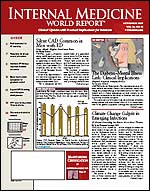Publication
Article
Internal Medicine World Report
Raloxifene for Breast Cancer Prophylaxis
Raloxifene HCl (Evista; Eli Lilly), previously indicated for osteoporosis in postmenopausal women, is now also indicated for the prevention of breast cancer in postmenopausal women at high risk for invasive breast cancer. Until now, physicians had only tamoxifen citrate to prescribe for women at high risk for breast cancer. Patients should be told that raloxifene does not completely prevent cancer. Breast examinations and mammograms should be done before starting raloxifene and regularly thereafter.
Raloxifene is thought to work by blocking estrogen receptors in the breast. Three placebo-controlled trials involving 15,234 postmenopausal women demonstrated that raloxifene reduced the risk of invasive breast cancer by 44% to 71%. A fourth clinical trial enrolling 19,747 postmenopausal women at high risk for breast cancer compared raloxifene to tamoxifen, showing similar efficacy for the 2 agents.
Because raloxifene can cause serious side effects (eg, venous thromboembolism [VTE], stroke), physicians should carefully evaluate the risks and benefits for each woman. Raloxifene is contraindicated in women with a history of VTE events. Raloxifene should not be prescribed for premenopausal women or for women who are or intend to become pregnant, because it may cause harm to the fetus. In addition, it should not be combined with cholestyramine (Prevalite, Questran) or estrogens.





